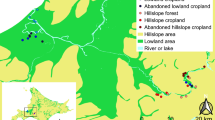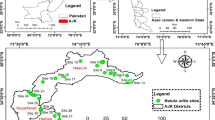Abstract
To understand the effects of global warming in tropical insect communities, it is necessary to comprehend how such communities respond to different abiotic factors that covariate with altitude. In this study, we partially answer this question applied to dung beetle communities distributed along an altitudinal gradient. The sampling was conducted in seven stations 100 m apart each in altitude in a dry mountain scrub in southern Ecuador. A total of 7422 individuals belonging to six species were captured. Canthon balteatus Boheman was the most abundant with 6502 individuals, and Onoreidium ohausi (Arrow) was the least abundant with 20 individuals. We found significant changes in the structure of the dung beetle communities with altitude. Two abiotic factors showed a relationship with the abundance pattern for all species (altitude, Z = 0.011, p < 0.01, and temperature, Z = 0.859, p < 0.01). Canthon balteatus Boheman showed a positive relationship with altitude (Z = 1.422, p < 0.001) and temperature (Z = 1.121, p < 0.001), Dichotomius problematicus (Lüederwaldt) a positive relationship with precipitation (Z = 0.113, p < 0.001), and Malagoniella cupreicollis (Waterhouse) a positive relationship with temperature (Z = 0.668, p < 0.001) and negative with precipitation (Z = −0.189, p < 0.001). Phanaeus achilles Boheman, Onthophagus sp., and O. ohausi (Arrow) did not show any relationship with the studied variables, nor was the richness correlated with the studied variables. These results suggest that the effects of global warming over dung beetle communities will be difficult to predict because of species-specific responses to global warming.

Similar content being viewed by others
References
Andresen E (2005) Effects of season and vegetation type on community organization of dung beetles in a tropical dry forest. Biotropica 37:291–300
Barragán F, Moreno CE, Escobar F, Halffter G, Navarrete D (2011) Negative impacts of human land use on dung beetle functional diversity. PLoS ONE 6(3):e17976. doi:10.1371/journal.pone.0017976
Barraza J, Montes J, Martínez N, Deloya C (2010) Ensamblaje de escarabajos coprófagos (Scarabaeidae: Scarabaeinae) del Bosque tropical Seco, Bahía Concha, Santa Marta (Colombia). Rev Colomb Entomol 36:285–291
Baselga A, Lobo JM, Svenning JC, Aráujo MB (2012) Global patterns in the shape of species geographical ranges reveal range determinants. J Biogeogr 39:760–771
Bohórquez J, Montoya J (2009) Abundancia y preferencia trófica de Dichotomius belus (Coleoptera: Scarabaeidae) en la Reserva Forestal de Colosó, Sucre. Bol Museo Entomol Univ del Valle 10:1–7
Bush MB (2002) Distributional change and conservation on the Andean flank: a palaeoecological perspective. Global Ecol Biogeogr 11:463–473
Bush MB, Silman MR, Urrego DH (2004) 48,000 years of climate and forest change in a biodiversity hot spot. Science 303:827–829
Bustos-Gómez L, Lopera A (2003) Preferencia por cebo de los escarabajos coprófagos (Coleoptera: Scarabaeidae: Scarabaeinae) de un remanente de bosque seco tropical al norte del Tolima (Colombia). In: Onore G, Reyes-Castillo P, Zunino M (eds) Escarabeidos de Latinoamérica: estado del conocimiento. Monografías Tercer Milenio vol. 3, SEA, Zaragoza, pp 59–65
Cambefort Y (1991) Biogeography and evolution. In: Hanski I, Cambefort Y (eds) Dung beetle ecology. Princeton University Press, Princeton, pp 51–67
Cambefort Y, Hanski I (1991) Dung beetle population biology. In: Hanski I, Cambefort Y (eds) Dung beetle ecology. Princeton University Press, Princeton, pp 36–50
Colwell R (2009) EstimateS: statistical estimation of species richness and shared species from samples. Version 8.2. User’s guide and application published at: http://purl.oclc.org/estimates. Accessed 10 Sept 2013
Colwell RK, Coddington JA (1994) Estimating terrestrial biodiversity through extrapolation. Philos T Roy Soc B 345:101–118
Davis AJ, Holloway JD, Huijbregts H, Krikken J, Kirk-Spriggs AH, Sutton SL (2001) Dung beetles as indicators of change in the forests of northern Borneo. J Appl Ecol 38:593–616
Diez JM, James TY, McMunn M, Ibáñez I (2013) Predicting species-specific responses of fungi to climatic variation using historical records. Glob Chang Biol 19:3145–3154
Dinerstein E, Olson DJ, Graham DM, Webster AL, Primm SA, Bookbinder MP, Ledec G (1995) A conservation assessment of the terrestrial ecoregions of Latin America and the Caribbean. The World Bank, Washington, p 129
Dufrêne M, Legendre P (1997) Species assemblages and indicator species: the need for a flexible asymmetrical approach. Ecol Monogr 67:345–366
Escobar F (1997) Estudio de la comunidad de coleópteros coprófagos (Scarabaeidae: Scarabaeinae) en un remanente de bosque seco al norte del Tolima. Caldasia 19:419–430
Escobar F, Lobo JM, Halffter G (2005) Altitudinal variation of dung beetle (Scarabaeidae: Scarabaeinae) assemblages in the Colombian Andes. Glob Ecol Biogeogr 14:327–337
Escobar F, Halffter G, Arellano L (2007) From forest to pasture: an evaluation of the influence of environment and biogeography on the structure of dung beetle (Scarabaeinae) assemblages along three altitudinal gradients in the Neotropical region. Ecography 30:193–208
Espinosa CI, Luzuriaga AL, de la Cruz M, Escudero A (2014) Climate and grazing control nurse effects in an Ecuadorian dry shrubby community. J Trop Ecol 30:23–32
Fischer A, Blaschke M, Bässler C (2011) Altitudinal gradients in biodiversity research: the state of the art and future perspectives under climate change aspects. Waldökologie, Landschaftsforschung und Naturschutz 11:35–47
Graham RW, Grimm EC (1990) Effects of global climate change on the patterns of terrestrial biological communities. Trends Ecol Evol 5:289–292
Halffter G, Arellano L (2002) Response of dung beetle diversity to human-induced changes in a tropical landscape. Biotropica 34:144–154
Hammer Ø, Harper DAT, Ryan PD (2001) PAST: paleontological statistics software package for education and data analysis. Paleontol Electr 4:1–9
Hanski I, Cambefort Y (1991) Dung beetle ecology. Princeton University Press, New Jersey, p 520
Herzog SK, Hamel-Leigue AC, Larsen TH, Mann DJ, Soria-Auza RW, Gill BD, Edmonds WD, Spector S (2013) Elevational distribution and conservation biogeography of Phanaeine dung beetles (Coleoptera: Scarabaeinae) in Bolivia. PLoS ONE 8:1–11
Hodkinson I (2005) Terrestrial insects along elevation gradients: species and community responses to altitude. Biol Rev 80:489–513
Jameson ML (1989) Diversity of coprophagous Scarabaeidae (Coleoptera) in grazed versus ungrazed sandhills prairie in western Nebraska. Trans Nebr Acad Sci 17:29–35
Janzen DH (1988) Tropical dry forests: the most endangered major tropical ecosystem. In: Wilson EO (ed) Biodiversity. National Academy Press, Washington DC, pp 130–137
Knapp M, Růžička J (2012) The effect of pitfall trap construction and preservative on catch size, species richness and species composition of ground beetles (Coleoptera: Carabidae). Eur J Entomol 109:419–426
Körner C (2007) The use of “altitude” in ecological research. Trends Ecol Evol 22:569–574
Larsen TH, Escobar F, Armbrecht I (2011) Insects of the Tropical Andes: diversity patterns, processes and global change. In: Herzog SK, Martínez R, Jørgensen PM, Tiessen H (eds) Climate change and biodiversity in the Tropical Andes. Inter-American Institute of Global Change Research (IAI) and Scientific Committee on Problems of the Environment (SCOPE), São José dos Campos and Paris, pp 228–244.
Lobo JM, Halffter G (2000) Biogeographical and ecological factors affecting the altitudinal variation of mountainous communities of coprophagous beetles (Coleoptera: Scarabaeoidea): a comparative study. Ann Entomol Soc Am 93:115–126
Lumaret J, Kirk A (1991) South temperate dung beetles. In: Hanski I, Cambefort Y (eds) Dung beetle ecology. Princeton University Press, Princeton, pp 97–115
Martínez NJ, Cañas LM, Rangel JL, Barraza JM, Montes JM, Blanco OR (2010) Coleópteros Coprófagos (Scarabaeidae: Scarabaeinae) en un fragmento de bosque seco tropical en el departamento del Atlántico, Colombia. Bol Mus Entomol Univ Valle 11:21–30
Maveety SA, Browne RA, Erwin TL (2011) Carabidae diversity along an altitudinal gradient in a Peruvian cloud forest (Coleoptera). Zoo Keys 147:651–666
McCain CM (2009) Global analysis of bird elevational diversity. Glob Ecol Biogeogr 18:346–360
McCain CM, Grytnes JA (2010) Elevational gradients in species richness. In: Encyclopedia of Life Sciences. Wiley, Chichester, pp 1–10. doi: 10.1002/9780470015902.a0022548
McCullagh P, Nelder J (1989) Generalized linear models. Chapman and Hall, London, p 506
Miles L, Newton AC, DeFries RS, Ravilious C, May I, Blyth S, Kapos V, Gordon JE (2006) A global overview of the conservation status of tropical dry forests. J Biogeogr 33:491–505
Nichols LA, Spector S, Louzada JNC, Larsen T, Amezquita S, Favila ME (2008) Ecological functions and ecosystem services provided by Scarabaeinae dung beetles. Biol Conserv 141:1461–1474
Noriega JA, Cubillos AM, Castañeda C, Sánchez AM (2008) Actividad diaria de colonización del recurso alimenticio en un ensamblaje de escarabajos coprófagos (Coleoptera: Scarabaeidae) en la Amazonía Colombiana. Acta Biol Colomb 13:73–84
Padilla-Gil D, Halffter G (2007) Biogeography of the areas and Canthonini (Coloptera: Scarabaeidae) of dry tropical forests in Mesoamerica and Colombia. Acta Zool Mex 23:73–108
Pucko C, Beckage B, Perkins T, Keeton WS (2011) Species shifts in response to climate change: individual or shared responses? J Torrey Bot Soc 138:156–176
R Development Core Team (2012) R: a language and environment for statistical computing. R Foundation for Statistical Computing, Vienna, Austria. ISBN 3-900051-07-0. http://www.R-proyect.org. Accessed 27 Sept 2013
Rahbek C (1995) The elevational gradient of species richness: a uniform pattern. Ecography 18:200–205
Rivera-Cervantes LE, Halffter G (1999) Monografía de las especies mexicanas de Canthon del subgénero Glaphirocanthon (Coleoptera: Scarabaeidae: Scarabaeinae). Acta Zool Mex 77:23–150
Sanders NJ, Rahbek C (2012) The patterns and causes of elevational diversity gradients. Ecography 35:1–3
Santoul F, Soulard A, Figuerola J, Céréghino R, Mastrorillo S (2004) Environmental factors influencing local fish species richness and differences between hydroregions in south-western France. Int Rev Hydrobiol 89:79–87
Sierra R (1999) Propuesta preliminar de un sistema de clasificación de vegetación para el Ecuador continental. Proyecto INEFAN/GEF y EcoCiencia, Quito, p 174
Silva P, Vaz-de-Mello FZ, Di Mare R (2013) Diversity and seasonality of Scarabaeinae (Coleoptera: Scarabaeidae) in forest fragments in Santa Maria, Rio Grande do Sul, Brazil. An Acad Bras Cienc 85:679–697
Simpson EH (1949) Measurement of species diversity. Nature 163:688
Stewart JR (2008) The progressive effect of the individualistic response of species to quaternary climate change: an analysis of British mammalian faunas. Quat Sci Rev 27:2499–2508
Tilman D, Naeem S, Knops J, Reich P, Siemann E, Wedin D, Ritchie M, Lawton J (1997) Biodiversity and ecosystem properties. Science 278:1866–1867
Vaz-De-Mello FZ, Edmonds WD, Ocampo FC, Schoolmeesters P (2011) A multilingual key to the genera and subgenera of the subfamily Scarabaeinae of the new world (Coleoptera: Scarabaeidae). Zootaxa 2854:1–73
Verdú J, Moreno CE, Sánchez-Rojas G, Numa C, Galante E, Halffter G (2007) Grazing promotes dung beetle diversity in the xeric landscape of a Mexican biosphere reserve. Biol Conserv 140:308–317
White GC, Bennetts RE (1996) Analysis of frequency count data using the negative binomial distribution. Ecology 77:2549–2557
Wolda H (1987) Altitude, habitat and tropical insect diversity. Biol J Linn Soc 30:313–323
Acknowledgments
We thank William Chamorro and Fernando Vaz de Mello for examining the collected materials. We also thank Marcos Méndez and David Donoso for their valuable contributions and for critically reviewing this manuscript. We thank to Carolyn Daher and Pablo Ruiz for English corrections. Two anonymous referees made valuable comments that have much improved the manuscript. We extend our gratitude to the Division of Systematics and Diversity from the Universidad Técnica Particular de Loja for making this study possible and to MALCA S.A. for the access to the study area.
Electronic supplementary material
The online version of this article (doi:10.1007/s13744-014-0261-6) contains supplementary material, which is available to authorized users.
Author information
Authors and Affiliations
Corresponding author
Additional information
Edited by Fernando B Noll – UNESP
Electronic supplementary material
Below is the link to the electronic supplementary material.
Online Resource 1
Abundance and richness of dung beetle communities per station (S1–S7) and month (August 2010–April 2011) in a dry mountain scrub (PDF 133 kb)
Rights and permissions
About this article
Cite this article
Domínguez, D., Marín-Armijos, D. & Ruiz, C. Structure of Dung Beetle Communities in an Altitudinal Gradient of Neotropical Dry Forest. Neotrop Entomol 44, 40–46 (2015). https://doi.org/10.1007/s13744-014-0261-6
Received:
Accepted:
Published:
Issue Date:
DOI: https://doi.org/10.1007/s13744-014-0261-6




